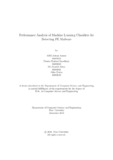| dc.contributor.advisor | Hossain, Muhammad Iqbal | |
| dc.contributor.author | Azmee, ABM.Adnan | |
| dc.contributor.author | Choudhury, Pranto Protim | |
| dc.contributor.author | Alam, Md.Aosaful | |
| dc.contributor.author | Dutta, Orko | |
| dc.date.accessioned | 2020-03-08T06:56:30Z | |
| dc.date.available | 2020-03-08T06:56:30Z | |
| dc.date.copyright | 2019 | |
| dc.date.issued | 2019-12 | |
| dc.identifier.other | ID 16101155 | |
| dc.identifier.other | ID 16101062 | |
| dc.identifier.other | ID 16101061 | |
| dc.identifier.other | ID 16101022 | |
| dc.identifier.uri | http://hdl.handle.net/10361/13837 | |
| dc.description | This thesis is submitted in partial fulfillment of the requirements for the degree of Bachelor of Science in Computer Science, 2019. | en_US |
| dc.description | Cataloged from PDF version of thesis. | |
| dc.description | Includes bibliographical references (pages 58-60). | |
| dc.description.abstract | In this modern era of technology, securing and protecting one's data has been a
major concern and needs to be focused on. Malware is a program that is designed
to cause harm and malware analysis is one of the paramount focused points under
the sight of cyber forensic professionals and network administrations. The degree
of the harm brought about by malignant programming varies to a great extent. If
this happens at home to a random person then that may lead to some loss of irrel-
evant or unimportant information but for a corporate network, it can lead to loss
of valuable business data. The existing research does focus on some few machine
learning algorithms to detect malware and very few of them worked with Portable
Executables (PE) les. However, we worked on the PE les and also for real-time
computation, a client-server model was developed by using Flask to detect malware
or benign. In this paper, we mainly focused on top classi cation algorithms and
compare their accuracy to nd out which one is giving the best result according to
the dataset and also compare among these algorithms. Top machine learning clas-
si cation algorithms were used alongside neural networks such as Arti cial Neural
Network, XGBoost, Support Vector Machine, Extra Tree Classi er, etc. The exper-
imental result shows that XGBoost achieved the highest accuracy of 98.62 percent
when compared with other approaches. Thus, to provide a better solution for this
kind of anomalies, we have been interested in researching malware detection and
want to contribute to building strong and protective cybersecurity. | en_US |
| dc.description.statementofresponsibility | ABM. Adnan Azmee | |
| dc.description.statementofresponsibility | Md. Aosaful Alam | |
| dc.description.statementofresponsibility | Pranto Protim Choudhury | |
| dc.description.statementofresponsibility | Orko Dutta | |
| dc.format.extent | 60 pages | |
| dc.format.extent | 60 pages | |
| dc.language.iso | en | en_US |
| dc.publisher | Brac University | en_US |
| dc.rights | Brac University theses are protected by copyright. They may be viewed from this source for any purpose, but reproduction or distribution in any format is prohibited without written permission. | |
| dc.subject | Malware detection | en_US |
| dc.subject | Machine learning | en_US |
| dc.subject | Data protection | en_US |
| dc.subject | XGBoost | en_US |
| dc.subject | Support Vector Machine | en_US |
| dc.subject | Extra Tree Classi er | en_US |
| dc.subject | Client- Server Model | en_US |
| dc.subject.lcsh | Neural networks | |
| dc.subject.lcsh | Machine learning | |
| dc.title | Performance analysis of machine learning classi ers for detecting PE malware | en_US |
| dc.type | Thesis | en_US |
| dc.contributor.department | Department of Computer Science and Engineering, Brac University | |
| dc.description.degree | B. Computer Science | |

